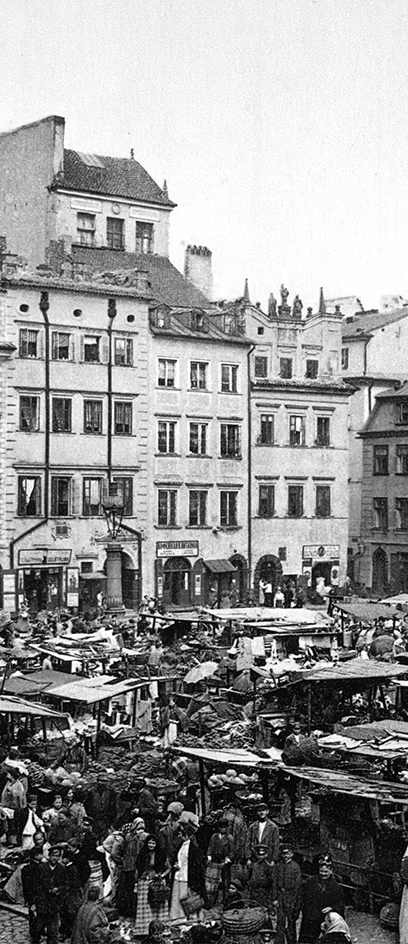 The Old Town
The Old Town
the oldest urban centre in Warsaw, founded in the thirteenth century.
The Old Town is one of the most extraordinary places on the map of Warsaw today. Completely obliterated during World War II, it emerged from the rubble, and thanks to the efforts of urban planners, architects, and Varsovians themselves the place was meticulously reconstructed. The architectural value of the rebuilt Old Town was appreciated in Poland and abroad, and in 1980 it became a UNESCO World Heritage Site.
The area of the Old Town in Warsaw is defined by Plac Zamkowy (Castle Square) and located in its eastern flank Royal Castle. This former residence of Polish kings, built in the fifteenth century was the former administrative and political centre of the whole Polish state. In the middle of the Castle Square there is a distinctive monument – Kolumna Zygmunta (Column of Sigismund III Vasa), Polish monarch of Swedish origin, who in 1596 decided to move the royal court from Kraków to Warsaw. The column was erected by the son of Zygmunt - Władyslaw IV, in the middle of seventeenth century.
In the vicinity of the Castle and Castle Square (which has existed only since the nineteenth century, earlier this space was not defined) beautiful Baroque and Renaissance tenement buildings are located. It is here where once townspeople lived - both those rich and the poor, serving the royal court.
The area of the Old Town was established based on the so-called Magdeburg RIghts. Old Town has a regular shape and is surrounded by city walls (which today are only preserved in fragments), in the centre of which there is the market square - the centre of the old Warsaw. The rebuilt market today is a vibrant place - full of attractive cafes and restaurants. At the centre of the square a statue of the Warsaw Mermaid stands – a symbol of Warsaw. In the houses in the north-eastern flank of the market, Historical Museum of the City of Warsaw is located, in which history of the capital city since ancient times is presented.
However, this is not the end of the secrets that the Old Town holds. Equally interesting as the market, are the unique, picturesque streets with their interesting monuments. Castle Square marks the beginning of Piwna (Beer) Street - the longest street in the Old Town, on which one of the most important religious buildings of the city is located, the church of St. Martin. It was built in the mid fourteenth century by the then Duke of Mazovia Ziemowit. The present appearance of the temple is the result of the baroque reconstruction in the eighteenth century. The church served a very important role in the second half of the twentieth century. In the late 70s and 80s representatives of the opposition gathered in it to protest against the oppressive policy of the communist authorities.
Parallel to Piwna runs Świętojańska (St. John's) street. Located on it there is another church, important for the history of not only Warsaw, but entire Poland. It is Archikatedra pod wezwaniem św. Jana Chrzciciela (St. John's Archcathedral) - the place where for centuries royal coronations, weddings and funerals were held. Here too, the Constitution of May 3, 1791 was proclaimed. In the basement of the cathedral a lot of people who made their mark in Polish history are buried - including the last king, Stanisław August Poniatowski, a distinguished pianist Ignacy Jan Paderewski, the Nobel Prize winner Henryk Sienkiewicz and finally Polish primate, Cardinal Stefan Wyszyński.
Świętojańska Street stretches to the north-west, where it meets the market and then turns into Nowomiejska street. The northern part of the Old Town is crowned by Barbican – a defensive structure from the sixteenth century, which is a conventional boundary between the Old and New Towns.
Do you know?
- During World War II approximately 90% of the Old Town buildings were destroyed. The castle was bombed early in the war, in September 1939. The majority of houses suffered during the Warsaw Uprising in 1944.
- The first stage of the reconstruction of the Old City was finished as early as 1953. A significant part of the tenement buildings together with the Old Town market square were completed and handed over for use at that time. The reconstruction of the cathedral continued until 1955 and in 1974 the inhabitants of Warsaw were presented with the finished Royal Castle (the interiors were under reconstruction until the eighties).
- During medieval times, the Old Town of Warsaw was on fire several times. This was due not so much to the hostilities rather that due to ordinary events (part of the buildings of the city were made of wood). As a result of the numerous reconstructions of houses, they have lost their former Gothic shape. Old fragments of the facades however, were partially restored by conservators during the post-war reconstruction. They can be seen today on the walls of many of the Old Town buildings.
- There are a lot of legends and myths associated with Warsaw's Old Town. The basement of the building at Krzywe Koło 13 street was inhabited by a basilisk - a lizard-like monster that turned anyone who looked at it to stone.
- Each flank of the Old Town market square has its own patron - selected from among eminent personalities associated with Warsaw in the eighteenth and nineteenth centuries. They are former socio-political activists - Franciszek Barss (eastern flank) and Hugo Kołłątaj (western flank) and presidents of Warsaw - Jan Dekert (northern flank) and Ignacy Wyssogota Zakrzewski (southern flank).






